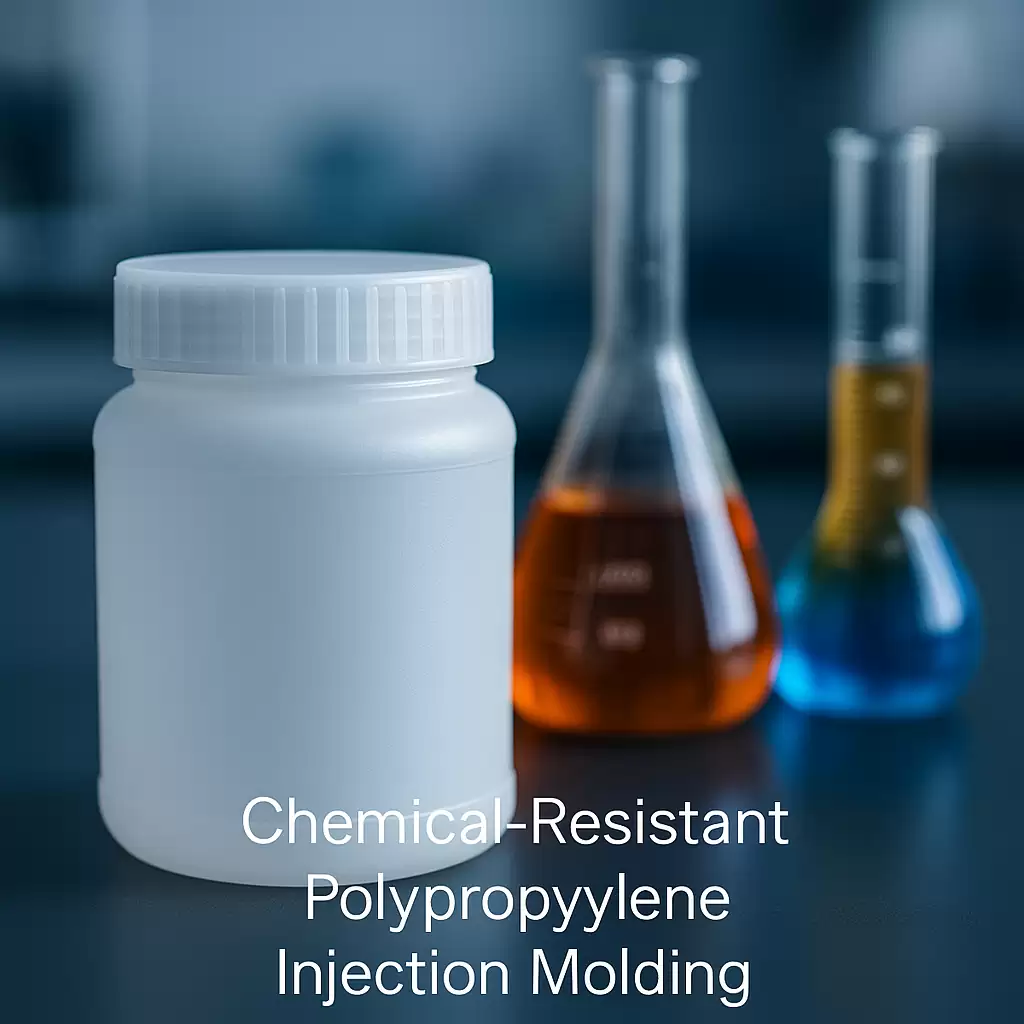Implement Polypropylene Injection Molding for Chemical-Resistant Solutions
Implement Polypropylene Injection Molding for Chemical-Resistant Solutions
Lightweight, fatigue-proof, and immune to most acids, bases, and organic solvents, polypropylene (PP) is the go-to polymer when engineers need parts that survive harsh chemical environments without expensive coatings or exotic alloys. By pairing the right PP grade with a data-driven molding process, you can create housings, valves, and fluid paths that shrug off corrosion, pass global compliance tests, and still hit aggressive cost targets. Below is a step-by-step playbook—design through validation—for leveraging polypropylene injection molding in your next chemical-resistant project.
1 | Why Polypropylene Beats Other “Budget” Resins in Chemical Service
| Property | PP Homo | PP Random | PP Impact | HDPE | ABS |
|---|---|---|---|---|---|
| Acid & Alkali Resistance | Excellent | Excellent | Very good | Very good | Poor |
| Organic Solvent Resistance | Very good | Very good | Good | Good | Fair |
| Continuous-Use Temp (°C) | 100 | 90 | 85 | 80 | 80 |
| Flex-Fatigue (Living Hinge) | Best | Best | Good | Fair | Poor |
| Cost (Asia, Q2-2025) | US $1.2–1.5 /kg | 1.3–1.6 | 1.4–1.7 | 1.1–1.4 | 2.2+ |
Takeaway – PP delivers top-tier chemical resistance without the price premium of PEEK or PVDF—and outlasts HDPE when cyclic flex or 90 °C service is required.
2 | Select the Right PP Grade for Your Chemical Environment
| Application | Recommended Grade | Key Additives |
|---|---|---|
| Lab-ware & reagent bottles | PP Homopolymer (high clarity) | Nucleating agent for faster cycle |
| Automotive DEF / AdBlue tanks | PP Copolymer (impact-modified) | UV stabiliser, 15 % talc for creep |
| Pump & valve internals | 30 % GF PP Copolymer | Silane-treated glass for acid resistance |
| Medical fluid paths | Gamma-stable PP Random | USP VI, ISO 10993 biocompatibility |
| Outdoor chemical totes | Impact PP + HALS UV masterbatch | Carbon-black < 0.3 % to reduce chalking |
3 | Design Guidelines for Chemical-Resistant PP Parts
-
Uniform Walls (2–3 mm) – Minimises differential shrink; thick sections can be cored because PP’s low viscosity fills easily.
-
Generous Radii (≥ 0.5 × wall) – Reduces stress concentration; chemicals attack stressed polymer chains first.
-
Living Hinges – Keep hinge thickness 0.3–0.4 mm; orient flow across the hinge for molecular alignment.
-
Integral Sealing Features – Mold in bead seals or crush ribs; PP’s low surface energy resists many adhesives.
-
Vent Placement – Position vents opposite the gate to prevent diesel-like “dieseling” marks in aggressive solvents.
4 | Process Window—Lock In Mechanical & Chemical Integrity
| Parameter | Typical PP Window | Impact on Chemical Performance |
|---|---|---|
| Melt Temp | 200–230 °C | Over-heating degrades chains → poor ESCR¹ |
| Mold Temp | 25–40 °C | Higher temp improves gloss & crystallinity |
| Injection Speed | Medium-High | Ensures knit-line strength in glass-filled PP |
| Pack Pressure | 90 % peak | Avoids voids that can trap chemicals |
| Cooling Time | Moldflow optimised | Uniform shrink = tight gasket fit |
¹ ESCR = Environmental Stress Crack Resistance.
5 | Additive & Filler Tuning for Extra Durability at Low Cost
-
Talc (10–20 %) – Doubles flexural modulus; minimal chemical reactivity; cost < US $0.05 /kg.
-
Glass Fibre (20–30 %) – Quintuples stiffness; use silane-treated glass to avoid acid wicking.
-
Hindered Amine Light Stabiliser (HALS) – Crucial for outdoor acid/alkali tanks; prevents chalking and brittleness.
-
PTFE Micro-Powder (5 %) – Lowers coefficient of friction for solvent-pump gears without affecting resistance.
6 | Case Snapshot — Chemical-Feed Pump Housing Upgrade
| Metric | Legacy ABS | Upgraded PP Copo + 30 % GF |
|---|---|---|
| Acetic Acid Soak (24 h, 60 °C) | Swelling 1.8 % | 0.4 % |
| Burst Pressure | 4.2 MPa | 5.6 MPa |
| Material Cost / kg | US $2.20 | US $1.40 |
| Annual Warranty Claims | 3.1 % | 0.5 % |
7 | Validation Checklist for Chemical-Exposure Parts
-
Soak Test – 24 h @ service temperature in worst-case chemical; measure swelling, weight gain.
-
ESCR – 10 % Igepal surfactant, 50 °C, bent strip method per ASTM D1693.
-
Burst / Pressure Cycle – 3× operating pressure, 1 000 cycles.
-
UV-Weather-O-Meter – 1 000 h Xenon ARC if outdoors.
-
Dimensional CpK – Target ≥ 1.33 on seal faces post-aging.
8 | Why Source PP Injection Molding via TaiwanMoldMaker.com
-
Material Breadth – 150 + PP grades in stock, from talc-filled homo to medical random copo.
-
Tooling Speed – Aluminium bridge tools in 3–4 weeks; hardened multi-cavity in 6–7.
-
Scientific Molding Labs – Cavity-pressure sensors and eDart® data ensure CpK ≥ 1.67 from T-1.
-
Integrated Secondary Ops – Laser marking, ultrasonic welding, and leak-testing under one roof.
-
Regulatory Support – ISO 10993, FDA master files, and EU Food Contact documentation supplied.
9 | Action Plan — Launch Your Chemical-Resistant PP Part Fast
-
Outline Chemical & Temperature Profile – acids, bases, solvents, sterilisation cycles.
-
Upload CAD & CTQs to TaiwanMoldMaker.com for 48-hour DFM & material matrix.
-
Approve Tool Concept – gate, cooling, and steel selection mapped to PP grade.
-
Prototype in Aluminium Tool – receive 50–100 parts in ≤ 4 weeks for soak and pressure validation.
-
Lock Process Window – DOE & CpK study; archive cavity-pressure signature.
-
Scale to Production – multi-cavity steel tool or family mould; optional Vendor-Managed Inventory.
Key Internal Links
Ready to engineer chemical-proof, cost-efficient parts? Upload your CAD files to TaiwanMoldMaker.com and receive a tailored polypropylene molding solution—quote, DFM, and timeline—in just 48 hours.









